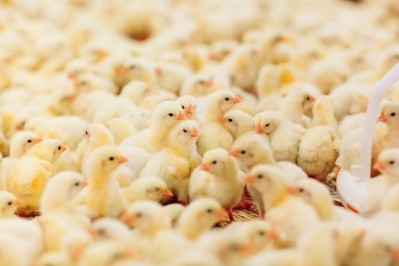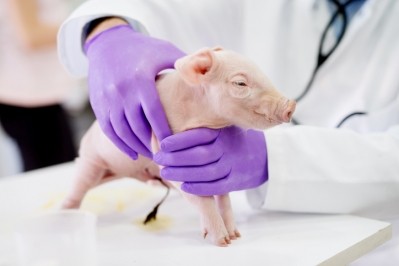Reviewers identify feed additives with antibacterial effects for use in piglet diets

Due to stress at weaning, piglets often receive antibiotics to treat diarrhea and health problems. There are potential cross-resistance problems, and the hunt is on for alternative nutritional concepts.
Researchers from Germany, Greece, Italy and Belgium carried out a review, which was published in The Veterinary Journal, evaluating the use of potential dietary feed additives (pDFA) with antibacterial effects and their impact on the performance of weaned piglets.
They said the pDFA in these studies could be grouped in five classes: antimicrobial peptides (AMP), chitosan, lysozyme, medium chain fatty acids/ triglycerides (MC FA/T) and plant extracts. Plant extracts and AMP contain a wide variety of pDFA, while lysozyme is a single pDFA, they noted.
FeedNavigator is hosting a webinar on weaning without zinc oxide on July 11. Our panel includes Alfons Jansman from WUR in the Netherlands, Charlotte Lauridsen from Aarhus University in Denmark and Lisbeth Shooter from the Danish pig research center, SEGES. Be sure to sign up for that: You can register for our free to access online event here.
They said their meta-analysis involved the identification of 23 peer-reviewed in vivo studies, comprising 50 trials, from the period January 2010 and January 2017. Those trials tested a weaning diet containing antibiotics versus pDFA with an antimicrobial mode of action, based on the two most occurring performance indicators: average daily gain (ADG) and feed conversion ratio (FCR).
Other performance indicators, such as the frequency of diarrhea and medication, were not included in the review, due to the limited data available in the consulted literature, they added.
Results
The reviewers said that, for each class of pDFA, results of the meta-analysis showed significantly higher average daily gain (ADG) in the group with pDFA compared to the negative control group, while no significant difference with the positive control group was observed.
“Furthermore, a positive effect on FCR was found, i.e. significantly less feed was needed to gain 1kg of body weight in the group with pDFA compared to the negative control group.
“No significant differences with positive control groups were observed for each class of pDFA, except for plant extracts, where the FCR was also significantly reduced in the treatment group.”
Findings per additive classification
Antimicrobial peptides
In six trials with antimicrobial peptides (AMPs), they saw that ADG was, on average, 22g higher compared to the negative control group, while in nine trials, overall, no significant difference with the positive control group was observed. Regarding FCR, on average, 96g less feed was needed in the treatment group compared to the negative control group to gain 1kg of body weight, while overall no significant difference with the positive control group was observed, said the reviewers.
“Antimicrobial peptides are potential alternatives to conventional antibiotics due to their broad-spectrum of activity, low level of induced resistance, and immunomodulatory properties (Peng et al., 2016),” noted the team.
Chitosan
They said there were only three trials from one study with chitosan. ADG was, on average, 34g higher compared to the negative control group, while, in general, no significant difference with the positive control group was observed. They said that, on average, 142g less feed was needed in the treatment group compared to the negative control group to gain 1kg of body weight, while, overall, no significant difference with the positive control group was observed.
“Although few trials were available using chitosan, it is clear from these trials that [it has] potential,” wrote the assessors.
Lysozyme
In 12 trials with lysozyme, ADG was, on average, 28g higher compared to the negative control group, while no significant difference with the positive control group was observed. On average, 52g less feed was needed in the treatment group compared to the negative control group to gain 1kg bodyweight, while, overall, no significant difference with the positive control group was observed.
“Lysozyme is a naturally occurring enzyme, and functions as an anti-microbial by cleaving the glycosidic linkage of bacterial cell walls peptidoglycan (Ellison and Giehl, 1991). Lysozyme is an important defence mechanism and is considered a part of the innate immune system in most mammals. Lysozyme is rather ineffective against Gram-negative bacteria due to the outer membrane barrier that surrounds and protects the peptidoglycan layer (Varahan et al., 2013). Also in the case of lysozyme, our meta-analysis shows the promising capacity to improve ADG and FCR compared to a negative control.”
Medium chain fatty acids or triglycerides
In six trials with MC FA/T, ADG was, on average, 28g higher compared to the negative control group, while in seven trials, overall, no significant difference with the positive control group was observed., said the reviewers. On average, 79g less feed was needed in the treatment group compared to the negative control group to gain 1kg of body weight, while overall no significant difference with the positive control group was observed.
“Medium chain fatty acids or triglycerides are organic acids with 6 to 12 carbon atoms. The mechanism(s) underlying the bactericidal activity of MC FA/T is not fully understood; however, many studies suggest that they act as nonionic surfactants, which become incorporated into the bacterial cell membrane (Bergsson et al., 2001, Altieri et al., 2009, Desbois and Smith, 2010).
“Studies also show that MC FA/T diffuse through the bacterial cell membrane and create transient or permanent pores, resulting in altered membrane permeability and cell death (Bergsson et al., 2001, Altieri et al., 2009, Desbois and Smith, 2010).”
Plant extracts and essential oils
The reviewers saw that in 13 trials with plant extracts and essential oils, ADG was, on average, 32g higher compared to the negative control group, while in 17 trials, overall, no significant difference with the positive control group was observed. On average, 79g less feed was needed in the treatment group compared to the negative control group to gain 1kg of body weight. Compared to the positive control group, on average, 75g less feed was needed in the treatment group to gain 1kg of body weight.
“Plant extracts and essential oils act along the animal digestive tract to improve appetite and modulate the microbiota, and are able to induce a number of other benefits (Franz et al., 2010). The antimicrobial properties of essential oils and extracts can be dose-dependently bacteriostatic and/or bactericidal. Several investigations have also shown their antioxidant effect, their effects on digestive physiology and digestion at weaning (Zabielski et al., 1999) and on the microbiology of the gut (Franz et al., 2010).
“From the amount of trials using plant extracts (17 out of 50), it is clear that they are most explored from all selected pDFA in this meta-analysis. Besides having a positive effect compared to a negative control, plant extracts also showed the capacity to improve FCR in comparison to a positive treatment with antimicrobials. However, ADG was not significantly different compared to a positive treatment.”
Source: The Veterinary Journal
DOI: https://doi.org/10.1016/j.tvjl.2019.04.017
Title: Potential dietary feed additives with antibacterial effects and their impact on performance of weaned piglets: A meta-analysis
Authors: W. Vanrolleghem, S. Tanghe, S. Verstringe. G. Bruggeman, D. Papadopoulos, P. Trevisi, J. Zentek, S. Sarrazin, J. Dewulf















